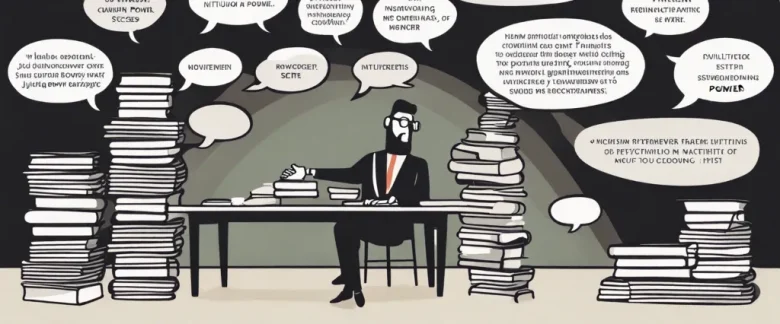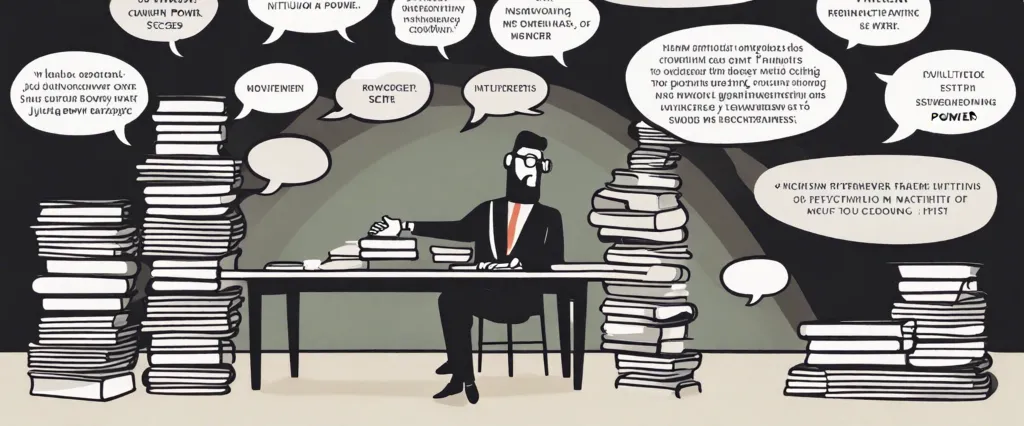In “Secrets of Power Negotiating,” acclaimed author Roger Dawson reveals invaluable techniques and insights to master the art of negotiation. By exploring the psychology of human behavior and emphasizing strategic approaches, Dawson equips readers with a powerful toolkit to navigate negotiations and achieve favorable outcomes in any situation. With his extensive experience as a negotiation expert and speaker, Dawson has long been renowned as a leading authority on the subject, delivering seminars and consulting with major corporations globally. His unparalleled expertise and practical advice make “Secrets of Power Negotiating” an essential resource for anyone seeking to enhance their negotiation skills and maximize their success.
Chapter 1: The Power of Negotiation
In Chapter 1 of Secrets of Power Negotiating by Roger Dawson, the concept of negotiation and its immense significance in various aspects of life is explored. The author emphasizes the idea that negotiation is not confined to business transactions alone but extends to personal relationships, politics, and everyday interactions.
Dawson explains that negotiation is synonymous with problem-solving and is a crucial skill that can be developed and improved. The chapter highlights the misconception that negotiation is a confrontational process, where someone has to lose for another to win. However, the author argues that successful negotiation involves finding mutually beneficial solutions that satisfy both parties.
Furthermore, Dawson introduces the concept of negotiation power and explains that it is not dependent on physical strength or personality traits. Instead, power in negotiation lies in one’s ability to understand the needs and desires of the other party, listen effectively, and find ways to create win-win outcomes.
The chapter concludes with the presentation of the five main reasons negotiation is essential in life. First, negotiation enables individuals to get what they want or need. Second, it helps to build and maintain relationships by fostering cooperation. Third, negotiation allows for creative problem-solving, finding solutions that may not be immediately apparent. Fourth, negotiation saves time, money, and resources by avoiding unnecessary conflicts. Finally, negotiation is a means to influence and persuade others effectively.
In summary, Chapter 1 of “Secrets of Power Negotiating” lays the foundation for understanding the importance of negotiation in various aspects of life. It highlights negotiation as a problem-solving tool and emphasizes the significance of finding mutually satisfying outcomes. Additionally, it demonstrates that negotiation power is not about dominance but rather about understanding and creating win-win scenarios.
Chapter 2: Preparing for Negotiation
Chapter 2 of “Secrets of Power Negotiating” by Roger Dawson focuses on the importance of thorough preparation before entering into a negotiation. Dawson believes that proper preparation is vital for success and enables negotiators to have the upper hand in any negotiation scenario.
The chapter begins by emphasizing the significance of knowing as much as possible about the other party involved in the negotiation. Dawson explains that researching and gathering information about their background, past negotiations, and their interests and needs will provide valuable insights and leverage during the negotiation process.
Furthermore, the chapter highlights the importance of setting clear and realistic goals before entering a negotiation. Dawson emphasizes the need to define what the negotiator’s desired outcome is, as well as determining their walk-away point if negotiations aren’t fruitful. He explains that this helps negotiators stay focused and not make impulsive decisions that could be detrimental to their interests.
Dawson also provides guidance on how to analyze and assess the other party’s style of negotiating. Understanding their preferred negotiation tactics and strategies can help negotiators plan countermeasures and formulate effective responses.
Additionally, the chapter emphasizes the significance of improving both communication and listening skills. Dawson emphasizes that by understanding body language, active listening, and effective questioning techniques, negotiators can gain valuable information and maintain better control of the negotiation.
Lastly, the chapter advises negotiators to anticipate potential obstacles and obstacles that may arise during the negotiation process. By considering all possible scenarios, negotiators can develop contingency plans and adapt their strategies accordingly.
In summary, Chapter 2 of “Secrets of Power Negotiating” stresses the importance of thorough preparation for negotiations. Dawson emphasizes gathering information about the other party, defining clear goals and limits, understanding negotiation styles, improving communication skills, and anticipating potential obstacles. Following these guidelines can provide negotiators with a significant advantage and increase their chances of achieving a favorable outcome.
Chapter 3: Building Rapport and Trust
Chapter 3 of the book “Secrets of Power Negotiating” by Roger Dawson delves into the importance of building rapport and trust while negotiating. Dawson begins the chapter by emphasizing the essential nature of rapport and trust in successful negotiations, as they serve as the foundation for open communication and collaboration.
To establish rapport, Dawson suggests finding commonalities between yourself and the other party, such as shared interests or experiences. By actively listening and being genuinely interested in the other person, you can build rapport and create a positive atmosphere for negotiations. Dawson also advises mirroring the other party’s body language and communication style to create a subconscious connection.
Trust-building is the next crucial step in negotiations. Dawson emphasizes the significance of integrity and honesty in earning trust. He highlights the importance of keeping promises, being consistent, and speaking the truth. Demonstrating competence and expertise in the subject matter also helps build trust.
In addition to personal attributes, Dawson explores the importance of establishing trust through preparation and credibility. Thoroughly researching the other party and understanding their needs and motivations is vital to create trusting relationships. Sharing credible information and supporting it with relevant evidence can further enhance your credibility.
The chapter also emphasizes the significance of professional behavior and ethics during negotiations. Dawson cautions against using manipulative tactics or lying, as these can undermine trust and damage relationships.
In summary, Chapter 3 of “Secrets of Power Negotiating” emphasizes the importance of building rapport and trust as the foundation for successful negotiations. By finding common ground, demonstrating integrity, competence, and credibility, negotiators can establish trust and create a positive atmosphere for productive discussions.
Chapter 4: Creating Win-Win Solutions

Chapter 4: Creating Win-Win Solutions of the book Secrets of Power Negotiating by Roger Dawson revolves around the concept of finding mutually beneficial solutions in negotiations. The chapter emphasizes the importance of moving away from a zero-sum mindset where one party’s gain is perceived as another party’s loss, towards a win-win approach that seeks to maximize the benefit for all parties involved.
Dawson introduces the concept of the “contrasting method,” which involves presenting alternatives to the other party that highlight the benefits they could gain from agreeing to your proposal. By framing the negotiation in a way that highlights the positive outcome for both sides, you can create a win-win situation that makes it easier for the other party to agree.
The chapter discusses the importance of empathy and understanding the other party’s needs and interests. Dawson emphasizes the need to ask questions and actively listen to the other party in order to gain insight into what they truly want and value. By understanding their motives, you can tailor your proposals to fit their needs, thus increasing the chances of reaching a mutually satisfactory agreement.
Furthermore, Dawson emphasizes the use of creative problem-solving techniques to find win-win solutions. He encourages negotiators to think outside the box and explore alternative options that may satisfy both parties’ interests. This involves brainstorming ideas and being open to compromise and trade-offs that benefit both sides.
Overall, Chapter 4 of Secrets of Power Negotiating highlights the importance of adopting a win-win mindset, understanding the other party’s needs, and utilizing creative problem-solving techniques to find mutually beneficial solutions. By focusing on creating value for all parties involved, negotiators can increase the chances of reaching successful outcomes in their negotiations.
Chapter 5: Overcoming Objections and Resistance
Chapter 5 of “Secrets of Power Negotiating” by Roger Dawson focuses on the strategies and techniques to overcome objections and resistance during negotiations. The chapter starts by emphasizing the importance of anticipating objections before they occur and addressing them proactively.
Dawson explains that objections can arise due to various reasons, such as price, quality, value, timing, or personal preferences. He advises negotiators to look for the hidden objection behind the initial one, as often the stated objection is not the real concern. By identifying the underlying issue, negotiators can tailor their responses and present solutions that genuinely address the other party’s concerns.
To counter objections effectively, Dawson introduces the concept of “Feel-Felt-Found” as a mnemonic technique. This method involves acknowledging and empathizing with the other party’s objection by saying, “I understand how you feel” (Feel), followed by citing examples of others who initially felt the same way but eventually changed their perspective (Felt), and finally presenting evidence of the positive results they achieved (Found). By using this approach, negotiators can neutralize objections and persuade the other party to reconsider their position.
Dawson also emphasizes the importance of asking the right questions to understand objections better. By probing and gathering additional information, negotiators can identify the root cause and address it effectively. Additionally, he suggests offering alternatives or compromises to overcome objections, as this demonstrates a willingness to work collaboratively towards a mutually beneficial agreement.
The chapter also discusses resistance during negotiations. Dawson explains that resistance can stem from fear, mistrust, or a concern for self-interest. To overcome resistance, negotiators should focus on building trust, demonstrating credibility, and identifying common interests. Dawson advises negotiators to avoid engaging in confrontations and instead encourage open and honest communication.
In summary, Chapter 5 of “Secrets of Power Negotiating” provides valuable insights and strategies to overcome objections and resistance during negotiations. By anticipating objections, understanding the underlying concerns, and employing effective techniques such as Feel-Felt-Found, negotiators can counter objections successfully. Additionally, by building trust, demonstrating credibility, and seeking common ground, negotiators can reduce resistance and create a positive environment for reaching mutually beneficial agreements.
Chapter 6: Negotiating with Power
Chapter 6 of “Secrets of Power Negotiating” by Roger Dawson focuses on the art of negotiating with power. Dawson highlights that negotiating with power means having the ability to influence and control the outcome of a negotiation. He emphasizes that power can come from various sources, such as knowledge, personality, position, or alternatives.
The chapter begins by explaining the importance of understanding the balance of power in a negotiation. Dawson states that the person with more power has an advantage, but it does not necessarily mean they will win. Skillful negotiators have the ability to level the playing field by understanding and utilizing different sources of power.
Dawson provides several strategies to negotiate with power. First, he suggests improving knowledge and doing thorough research, as it enhances confidence and credibility. Second, he highlights the advantage of developing a strong personality by being friendly, but assertive. Being confident and willing to walk away when necessary can also increase one’s power in a negotiation.
The author also emphasizes that the power of alternatives is crucial. Having alternatives gives negotiators the ability to walk away and pursue other options, which increases their power position. Dawson advises creating alternatives by networking, building relationships, and exploring different options.
Furthermore, Dawson introduces the concept of positional power, which comes from one’s position or title. He explains how individuals can leverage their position to gain power in a negotiation. However, he also warns against solely relying on positional power, as it may not be effective in every situation.
In summary, Chapter 6 of “Secrets of Power Negotiating” provides valuable insights into negotiating with power. It emphasizes the importance of understanding the balance of power, improving knowledge, developing a strong personality, creating alternatives, and utilizing positional power. By effectively using these strategies, negotiators can achieve better outcomes and navigate negotiations with confidence and success.
Chapter 7: Dealing with Difficult Negotiators
In Chapter 7 of “Secrets of Power Negotiating” by Roger Dawson, titled “Dealing with Difficult Negotiators,” the author provides essential strategies for handling challenging individuals in the negotiation process. Dawson emphasizes the importance of remaining calm and composed while dealing with difficult negotiators, as losing control can hinder progress and lead to unfavorable outcomes.
The chapter begins by presenting the “Boulwarism” negotiation tactic, which involves making take-it-or-leave-it offers and refusing to negotiate further. Dawson advises negotiators not to fall into the trap of getting defensive or engaging in heated arguments under such circumstances but rather suggests using the “Good Guy-Bad Guy” technique, where one member of the negotiation team appears to be on the other party’s side, thereby leveraging their position to gain concessions.
Furthermore, the author focuses on the negotiation dance of “Never Split the Difference.” According to Dawson, skilled negotiators often use this technique by demanding unreasonable concessions to create an illusion of compromise when they make smaller demands. Recognizing this tactic and avoiding falling into the trap of making major concessions is crucial.
Additionally, Dawson introduces the negotiation strategy of dealing with “Aggressive Personalities.” He advises negotiators to identify the specific type of aggressive negotiator they are dealing with, such as the “Retaliator” or the “Vitriolic,” and tailor their approach accordingly. For instance, reflecting the aggressive behavior of a retaliator can help establish a sense of equality, reducing their aggression.
The chapter concludes with Dawson’s recommendation of recognizing “Urgency Tactics.” These tactics involve placing pressure on negotiators to quickly accept unfavorable terms due to a perceived urgency. By acknowledging these tactics, negotiators can maintain their position and avoid being pushed into hasty decisions.
Overall, Chapter 7 of “Secrets of Power Negotiating” provides valuable insights and practical techniques for effectively handling difficult negotiators, emphasizing the significance of composure, strategic thinking, and an understanding of various negotiation tactics to achieve successful outcomes.

Chapter 8: Closing the Deal and Following Up
Chapter 8 of “Secrets of Power Negotiating” by Roger Dawson focuses on the crucial stage of closing the deal and following up. The chapter emphasizes the significance of these steps in achieving successful negotiations and building long-term relationships.
Dawson begins by stressing the importance of signaling your intention to close the deal without being overly aggressive or confrontational. He advises negotiators to create an atmosphere that encourages the other party to feel comfortable in making a commitment. By establishing a sense of urgency, negotiators can motivate their counterparts to take action.
The author then highlights the significance of concession-making during the closing process. He suggests that making minor concessions can close the gap between parties and create an environment of goodwill. However, Dawson warns against conceding too much or becoming desperate, as this can weaken one’s position and lead to a negative outcome.
Furthermore, the chapter delves into the art of using different closing techniques. Dawson provides several closing strategies, such as the “alternative choice” technique, where negotiators present options to the other party, ensuring they feel in control of the decision-making process. He also discusses the power of silence, using it to create discomfort and push the other party towards committing.
Following up becomes crucial after closing a deal, as it helps solidify the agreement and maintains a positive relationship. Dawson advises sending a brief note of appreciation and summarizing the key points agreed upon. Following up also allows negotiators to address any potential issues or concerns that may arise after the deal is closed.
In summary, Chapter 8 of “Secrets of Power Negotiating” delves into the art of closing deals and the significance of effective follow-up. It highlights the importance of creating a conducive atmosphere, making concessions strategically, and employing various closing techniques. The chapter underscores the value of follow-up in maintaining relationships and resolving any post-deal issues.
After Reading
In conclusion, “Secrets of Power Negotiating” by Roger Dawson is an insightful and practical guide to mastering the art of negotiation. The book emphasizes the importance of preparation, building rapport, and leveraging leverage in order to achieve favorable outcomes. Dawson’s strategies, techniques, and real-life examples provide readers with a comprehensive understanding of negotiation dynamics and how to navigate challenging situations effectively. Whether in business or personal interactions, this book offers valuable tools and mindset shifts that empower individuals to communicate persuasively, anticipate counterarguments, and achieve win-win outcomes. Overall, “Secrets of Power Negotiating” equips readers with the necessary skills and confidence to become skilled negotiators and consistently secure beneficial agreements.
1. Never Split the Difference: Negotiating As If Your Life Depended On It” by Chris Voss – Chris Voss, a former FBI negotiator, provides valuable insights on negotiating techniques and strategies. This book explores the art of high-stake negotiations and offers practical advice for everyday situations.
2. Getting to Yes: Negotiating Agreement Without Giving In” by Roger Fisher and William Ury – Considered a classic in the field of negotiation, this book offers a straightforward approach to reaching mutually satisfying agreements. The authors emphasize the importance of separating people from the problem while maintaining a focus on interests rather than positions.
3. Influence: The Psychology of Persuasion” by Robert Cialdini – Understanding the principles of influence is crucial in negotiation. Cialdini’s book explores the psychology and tactics behind persuasive communication. It provides useful strategies to enhance your ability to persuade and negotiate effectively.
4. “The Art of Woo: Using Strategic Persuasion to Sell Your Ideas” by G. Richard Shell and Mario Moussa – This book delves into the art of “wooing,” combining persuasion, relationship-building, and negotiation to achieve positive outcomes. Shell and Moussa present practical strategies and approaches for influencing others and gaining their support.
5. Difficult Conversations: How to Discuss What Matters Most” by Douglas Stone, Bruce Patton, and Sheila Heen – Negotiation often involves challenging conversations. This book provides practical guidance on tackling difficult discussions, managing emotions, and communicating effectively. By mastering these skills, negotiators can navigate tough situations while promoting positive outcomes.




